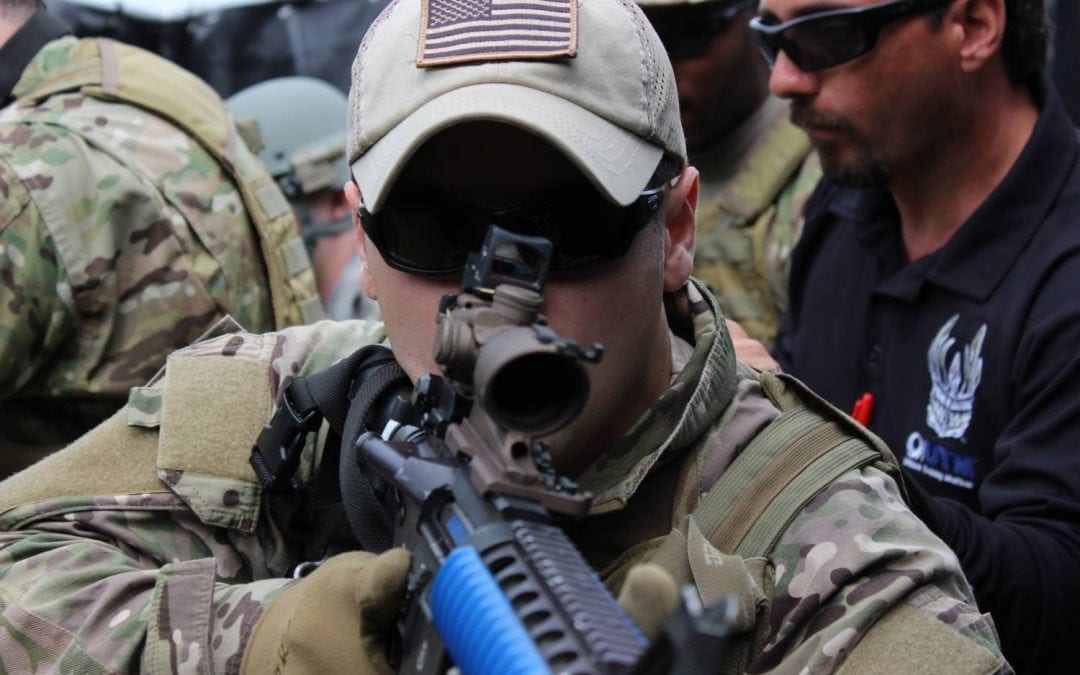Techniques vs. Concepts
Over the years, two prevailing schools of thought have emerged regarding how to develop training. They are the technique based, muscle memory approach and the more concept driven one, which is built around the body’s natural response to a given threat or problem. Trainers have traditionally viewed these two theories as mutually exclusive, meaning that it was either one or the other but not both. This fact, however, is unfortunate since there is value to be gained from each and maximum benefit in the combination of both approaches being integrated into developing law enforcement officer or soldier survival skills.
Let’s look at the muscle memory and technique repetition based foundational approach. Most trainers have heard the old phrase “do something a thousand times and it is yours”, which has merit in training the body to perform a gross or even complex motor skill such as a kick, punch or even manipulating a weapon. Anyone who has taught holster draw, reloads, CQB or combatives for example, can agree that this makes sense. There is just no substitute for puttng in the time and performing a skill until you become proficient. Maybe then it is the definition of proficient that is the question. Some may say, proficiency is an end point and I would argue that it is a only beginning point – where learning begins For instance, gettng your black belt after years of practice and training is only the genesis or birth of knowledge not the goal. Seeing proficiency in a skill or technique as a anything other than simply a springboard to humble yourself and start fresh leads to complacency, which as we all know, is a law enforcement officer’s or soldier’s worst enemy.
So although practicing individual skills and techniques is important and we know to be aware of, the often times, ‘deadly complacency phenomenon’, the question still remains, is this enough? The problem arises in training when we become single minded and reduce our approach to simple stimulus response exercise in a sterile training environment. To illustrate, let’s consider the areas this approach alone brings into question by using the common example of a simple drill, “Draw and Fire” from holster – maybe even incorporating reloads or clearing a malfunction to make it interesting. Anyone can practice and become range proficient and accurate but lets remember the goal for law enforcement and military, the ability to be combat effective not range effective Yes, experience is the best teacher but how do we prepare our soldiers or officers who lack combat or street experience, which often comes at a price and does not always provide a second chance to get it right.
First, muscle memory reliance alone does not consider the variables of an unpredictable dynamic situation. A static reload performed thousands of times on an indoor range is not the same as when we have to move to cover at the same time, dodge incoming rounds or fight through injury. Combatives training is good way to further explain the idea. How many guys have you seen that look great hitting the bag but perform poorly in the ring or in a real fight? Same principle here, you can teach anyone to manipulate a pistol or rifle standing still with someone blowing a whistle or calling out range commands but that does not always translate to fight effectiveness.
Next, muscle memory alone does not take into account the individuals natural physiological response to stress. If I toss you a baseball a hundred times, you will probably catch it 99 times pretty easily but if I toss you a grenade with the pin pulled out a few times that same seemingly simple motor skill becomes not quite so simple. We even see this in professional athletes who perform well in practice but not on game day. Why is that? They have the skill but applying it under stress hinders their performance because practice seldom replicates the realities of the game or in our case, the fight.
Finally, the technique and muscle memory alone approach does not inherently consider the value of judgment in real life situations. If we simply train ourselves to draw and shoot when a target faces us on the range and that is it, we are sort of like a teenager playing a video game where they shoot all the zombies that pop up. Unlike video games where there is no penalty for shooting the wrong zombie, there are real life consequences anytime you point your weapon, let a lone fire a round. Even in force-on-force training, instructors need to insert ample placebo scenarios where there is a “no shoot” and students are required to use an appropriate level of discretion under stress which is not always an easy thing to do when you heart rate is 180 beats per minute and your hands are sweating.
Conversely, what about the more conceptual based, no techniques, just do what the body wants to naturally approach as an autonomous system for training? There is a lot of merit to this as well but lets consider this as a stand alone school of thought. Some followers of this school believe that high level concepts can be presented to trainees followed by immersing the student into various realistic situations which will allow them to work through the problem as opposed to encumbering them with a lot of techniques they will never remember anyway. Once again a very valid approach in part because it allows you to do what comes naturally in response to a given obstacle and work through the problem. It is full of variables, allowing you to work under stress and fosters the “never give up” mindset. All good stuff and quite frankly there is no script on the street so why practice that way?
There are limitations to this as well though. It is clearly beneficial to develop and learn specific skills especially complex ones. Is there really a body’s natural response to clearing a double feed malfunction of a handgun? Or how about two team members navigating a “T” intersection in a hallway during an active shooter event? What about gettng tackled by a methamphetamine pumped up former college wrestler? Do you want to do what comes naturally or maybe learn some concepts backed up by time tested counters, maneuvers and techniques as a starting point? In punctuating this point, I hate to use the phrase that has been beaten to death, but maybe some tools in your toolbox wouldn’t hurt? You have to practice what you need to know, period and have those skills be mission specific when possible and only then push the limits and transcend the techniques until it is now yours This also allows you to adapt and overcome in an unfamiliar situation. Do it a thousand times? Yes for sure but do it with movement, 360° danger zones, stress, judgment, chaos whatever, so that it becomes part of your physical, psychological and emotional repertoire.
So at the end of the day, no two people will respond identically to an external stressful stimulus such as like having a gun stuck in your face, dodging a fixed bladed knife being swung at you or reloading under fire, so why would we simply take a class of 30 students and feed them a series of rehearsed and predetermined maneuvers, tactics or techniques and assume they will be able to perform that exact technique when their life is on the line? I hear many of you saying, “we would never do that” but don’t we? With all the safety, budget, facility limitations, adherence to ‘the way we have always done things’, training culture and the cloud of perceived liability, are we focused more on some sort of documentable qualifications at the cost of survivability? Do we accept what a certain instructor says based on his background and resume without testing it ourselves? It is sport, range or street based? If you are reading this then you are probably as motivated as I am to teach skills that bring law enforcement officers and soldiers home alive so we need to think outside the box, to work within the limitations we are given by administrators and still provide effective training. Force-on-Force training and non-lethal training ammunition are primary sets of tools that help to bridge the gap between the problem and the solution, but that is a topic for another day.
The take home suggestion here is that both schools of thought have value when put into context and should be applied together. Learn skills and techniques and practice diligently but remember, do not go through the motions of rehearsed techniques but apply them in training under stress, with as many variables and judgment at real speed so you can see what works for you the first time in training and not for the first time on the street or the battlefield where consequences can be severe. ‘Mat room folly’ is real – there is no argument against the statement, “If you slow any training down far enough it will always work” – it just will not work in the face and stress of reality Developing proficiency in a technique is merely your starting point. Training beyond this is where you will see the progression of your skills go from holding on to what you were taught or thought you knew to adapting and developing past your limitations.
Start with a technique or skill-set and then perform a number of drills and skill builders to develop the skill further in a variety of positions, angles, terrain and variables then begin introducing stress inoculation after the skill has been practiced and some level of proficiency is verified.
Incorporate realism at every step by having the student train in the context of his/her job without going into full blown scenarios. Never be locked into one school of thought or way of thinking, you don’t have to pick a team here. Think outside the box and put any theory, technique, style or system to the test to see what works and what does not – always, always, always test your protocol.
In future articles, we will give more examples and methods as well as our training model, which allows the trainer to apply this approach into any program either directly or through reverse engineering.
Until then stay safe and train real!
Author: Rob Lambraia, UTM Director of Training


